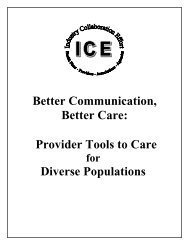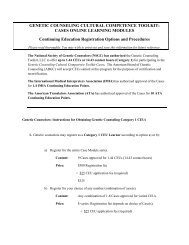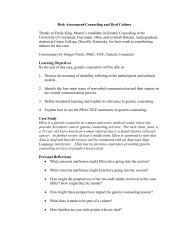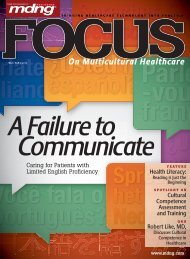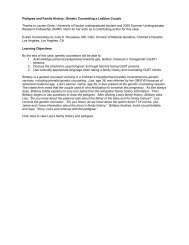Advanced Effective Communication, Cultural Competence, and ...
Advanced Effective Communication, Cultural Competence, and ...
Advanced Effective Communication, Cultural Competence, and ...
You also want an ePaper? Increase the reach of your titles
YUMPU automatically turns print PDFs into web optimized ePapers that Google loves.
A Roadmap for Hospitals<br />
Introduction<br />
Table 2. Checklist to Improve <strong>Effective</strong> <strong>Communication</strong>, <strong>Cultural</strong><br />
<strong>Competence</strong>, <strong>and</strong> Patient- <strong>and</strong> Family-Centered Care Across the<br />
Care Continuum (continued)<br />
❑ Developasystemtocollectpatientlanguageinformation.<br />
❑ Makesurethehospitalhasaprocesstocollect<br />
additionalpatient-levelinformation.<br />
Workforce<br />
❑ Targetrecruitmenteffortstoincreasethepoolofdiverse<br />
<strong>and</strong>bilingualc<strong>and</strong>idates.<br />
❑ Ensurethecompetencyofindividualsproviding<br />
languageservices.<br />
❑ Incorporatetheissuesofeffectivecommunication,<br />
culturalcompetence,<strong>and</strong>patient-<strong>and</strong>family-centered<br />
careintoneworexistingstafftrainingcurricula.<br />
❑ Identifystaffconcernsorsuggestedimprovementsfor<br />
providingcarethatmeetsuniquepatientneeds.<br />
Provision of Care, Treatment, <strong>and</strong> Services<br />
❑<br />
❑<br />
❑<br />
❑<br />
❑<br />
Createanenvironmentthatisinclusiveofallpatients.<br />
Developasystemtoprovidelanguageservices.<br />
Addressthecommunicationneedsofpatientswith<br />
sensoryorcommunicationimpairments.<br />
Integratehealthliteracystrategiesintopatient<br />
discussions<strong>and</strong>materials.<br />
Incorporateculturalcompetence<strong>and</strong>patient-<strong>and</strong><br />
family-centeredcareconceptsintocaredelivery.<br />
Patient, Family, <strong>and</strong> Community Engagement<br />
❑ Collectfeedbackfrompatients,families,<strong>and</strong>the<br />
surroundingcommunity.<br />
❑ Shareinformationwiththesurroundingcommunity<br />
aboutthehospital’seffortstomeetuniquepatientneeds.<br />
To Evaluate Compliance with Relevant<br />
Laws, Regulations, <strong>and</strong> St<strong>and</strong>ards<br />
The Roadmap for Hospitals was designed to help hospitals<br />
improve care. By focusing on this intent of the monograph, a<br />
hospital will also help ready itself for regulatory <strong>and</strong><br />
compliance surveys. In addition to the information provided<br />
in the core chapters, many of the appendices provide<br />
additional compliance resources. Appendix B (page 49)<br />
includes an overview of current Joint Commission<br />
accreditation requirenents for hospitals that support effective<br />
communication, cultural competence, <strong>and</strong> patient- <strong>and</strong><br />
family-centered care. Appendix C (page 57) provides<br />
additional context <strong>and</strong> information about how The Joint<br />
Commission may evaluate compliance with the new patientcentered<br />
communication st<strong>and</strong>ards. Appendix D (page 65)<br />
provides other supportive information including relevant laws<br />
<strong>and</strong> regulations. It explains what hospitals should do to be<br />
compliant with federal laws for language services, nondiscrimination,<br />
<strong>and</strong> environmental accessibility.<br />
The Roadmap for Hospitals provides a comprehensive view of<br />
many considerations to support effective communication,<br />
cultural competence, <strong>and</strong> patient- <strong>and</strong> family-centered care. We<br />
begin with chapters focused on points along the care<br />
continuum <strong>and</strong> practices that most directly impact the patient.<br />
However, appropriate organization systems <strong>and</strong> resources must<br />
be in place to support care practices. Therefore, it will be most<br />
effective for readers to consider the guide in its entirety.<br />
References:<br />
1. Smedley B.D., Stith A.Y., Nelson A.R.: Unequal Treatment: Confronting<br />
Racial <strong>and</strong> Ethnic Disparities in Health Care. Washington,<br />
DC: National Academy Press, 2002.<br />
2. Agency for Healthcare Research <strong>and</strong> Quality: National Healthcare<br />
Disparities Report, 2006. Rockville, MD: U.S. Department of<br />
Health <strong>and</strong> Human Services, Agency for Healthcare Research <strong>and</strong><br />
Quality, 2006. Available at http://www.ahrq.gov/qual/nhdr06/<br />
nhdr06.htm. (Accessed March 1, 2010.)<br />
3. Office of the Surgeon General: The 2005 Surgeon General’s Call to<br />
Action to Improve the Health <strong>and</strong> Wellness of Persons with Disabilities:<br />
What It Means to You: Rockville, MD: U.S. Department of Health<br />
<strong>and</strong> Human Services, Office of the Surgeon General, 2005. Available<br />
at http://www.surgeongeneral.gov/library/disabilities/call<br />
toaction/whatitmeanstoyou.pdf. (Accessed April 15, 2010.)<br />
4. Delpercio A.: Healthcare Equality Index 2010. Washington, DC:<br />
Human Rights Campaign Foundation <strong>and</strong> Gay <strong>and</strong> Lesbian Medical<br />
6


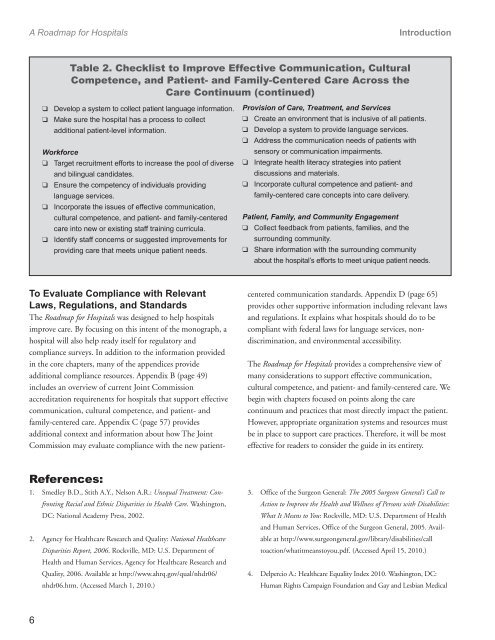
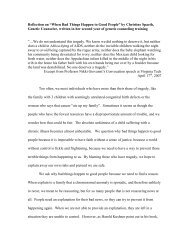
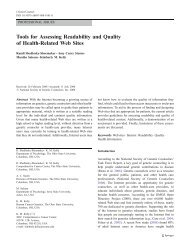

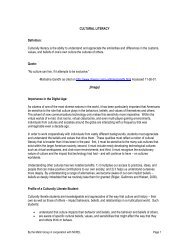
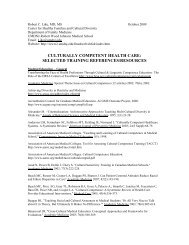

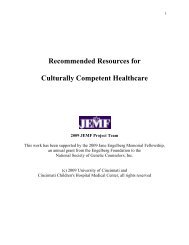

![Breaking Bad News PPT[1] - Genetic Counseling Cultural ...](https://img.yumpu.com/35003134/1/190x146/breaking-bad-news-ppt1-genetic-counseling-cultural-.jpg?quality=85)
